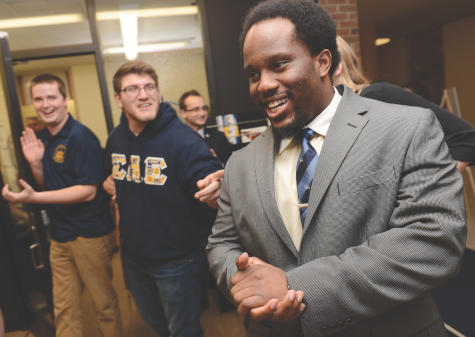Students use Rate my Professors to help schedule classes
August 27, 2015
When frantically scheduling for next semester’s classes at 12:01 a.m. as hundreds of other students try to get into a class with 20 open seats, it can be difficult to decide which professor will provide students with the best classroom experience.
One option available to students is using Rate My Professors, a website founded in 1999 made up of user-generated ratings about college professors and universities across the country.
According to its website, Rate My Professors has more than 15 million ratings, 1.4 million professors and 7,000 schools. The website also says more than 4 million students visit Rate My Professors each month.
“Choosing the best courses and professors is a rite of passage for every student, and connecting with peers on the site has become a key way for millions of students to navigate this process,” the site says. “The site does what students have been doing forever – checking in with each other – their friends, their brothers, their sisters, their classmates – to figure out who’s a great professor and who’s one you might want to avoid.”
The website allows students to rate their professors on four criteria: helpfulness, clarity, easiness and hotness, as well as an overall quality grade.
“I actually use it all of the time,” senior economics major Seth Becker said. “Each semester, when it’s time to schedule classes, I check it to make sure I’m not going to pick a professor that may not work with me well.”
However, not all professors think the website is a good resource.
“I think that we all gather here to learn and gather here to gain knowledge, and I think that it is absolutely inappropriate,” said Maryann Raghanti, associate professor of anthropology.
Raghanti said someone told her about the website, so she looked herself up to see if she had students rating her, and she did – users had given her an overall quality rating of 4.5 out of 5 and had also awarded a “chili pepper” for hotness.
“I don’t honestly think that it is extremely accurate,” Becker said. “You could have students that didn’t like the professor for various reasons, but that doesn’t mean the rest of the class didn’t. You should check with other students if you’re really concerned and not fully rely on the website.”
The website also allows students to anonymously expand on their ratings by giving a brief description of their experiences with the professor.
Kristen Steigerwald, a senior integrated health studies major, said because multiple students post ratings and comments, it gives a more accurate depiction of the professor.
“The only reason I think it’s accurate is because most of the time, more than one person posts about a professor,” she said. “So you’re not just basing it off one person’s experience or opinion, and usually what they say on there is true after I take the class. “
Raghanti said she teaches hundreds of students each year but only has about 30 ratings on the website. She said she believes only students at the extreme ends of the spectrum – those who loved and those who hated the professor – are rating professors; those who had an average experience aren’t getting on the site.
“My recollection is that there are just a handful for each of the faculty in my department whereas each of the faculty has thousands of students,” she said. “So you have a very small sampling fraction, and whenever you have that you have a huge amount of error. So people are either logging in because they really love that professor or they really hate that professor. You don’t have the majority viewpoint.”
The site features a “Professors Strike Back” feature, which allows professors to post either comments or videos in response to students’ ratings.
For example, Karl Idsvoog, associate professor of journalism and mass communication, posted a video titled, “Eats children for lunch, not breakfast,” in response to harsh comments from students and an overall quality rating of 2.7.
Jennifer Kulics, interim associate vice president and dean of students, said students should also ask peers, talk to their academic department and check syllabi to form opinions about their professors.
“Rate My Professors, to me, is like any other social media platform,” she said. “It offers opinions, I would say individual insight and perspectives, but cannot prove that it’s factual.”
Contact Chelsea Graff at [email protected].
























